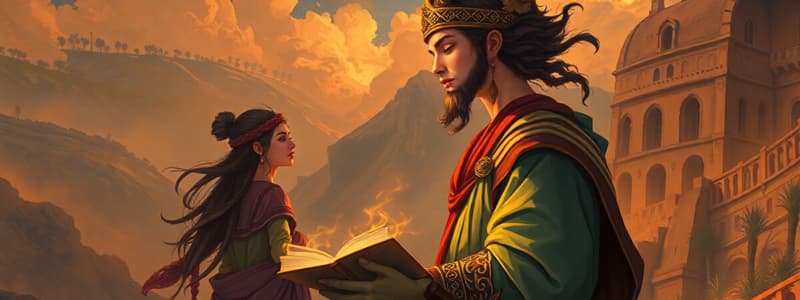Podcast
Questions and Answers
What invention by Gutenberg significantly contributed to the rapid spread of science and culture during the Renaissance?
What invention by Gutenberg significantly contributed to the rapid spread of science and culture during the Renaissance?
- The microscope
- The telescope
- The printing press (correct)
- The steam engine
The Renaissance emphasized a belief that humans were the center of the universe.
The Renaissance emphasized a belief that humans were the center of the universe.
True (A)
Who wrote 'The Lusiads' and what event does it recount?
Who wrote 'The Lusiads' and what event does it recount?
Luis de Camões; it recounts Vasco de Gama's voyage to India.
The Renaissance was marked by a revival of _______ poetry, characterized by themes from classical antiquity.
The Renaissance was marked by a revival of _______ poetry, characterized by themes from classical antiquity.
Match the following Renaissance figures or works to their contributions:
Match the following Renaissance figures or works to their contributions:
Which poet is known for mythological and pastoral poems?
Which poet is known for mythological and pastoral poems?
La Celestina is a narrative poem that tells the story of Calisto and Melibea.
La Celestina is a narrative poem that tells the story of Calisto and Melibea.
What is the primary theme explored in Nicolás Maquiavelo's 'El Príncipe'?
What is the primary theme explored in Nicolás Maquiavelo's 'El Príncipe'?
Pierre de Ronsard dedicated his poems to __________.
Pierre de Ronsard dedicated his poems to __________.
Match the following Renaissance works with their authors:
Match the following Renaissance works with their authors:
Which characteristic of the Baroque Period reflects a tendency toward complex and extravagant forms of expression?
Which characteristic of the Baroque Period reflects a tendency toward complex and extravagant forms of expression?
Miguel de Cervantes wrote the play 'Life is a Dream'.
Miguel de Cervantes wrote the play 'Life is a Dream'.
Name one major theme explored in Baroque poetry.
Name one major theme explored in Baroque poetry.
__________ wrote the poem 'Fábula de Polifemo y Galatea'.
__________ wrote the poem 'Fábula de Polifemo y Galatea'.
Match the following authors to their notable works:
Match the following authors to their notable works:
Flashcards
Anthropocentrism in the Renaissance
Anthropocentrism in the Renaissance
The belief that humans are the center of the universe and have great importance.
Classical Culture in the Renaissance
Classical Culture in the Renaissance
The rediscovery and appreciation of the art, literature, and philosophy of ancient Greece and Rome.
Scientific Revolution in the Renaissance
Scientific Revolution in the Renaissance
A new way of thinking that emphasized reason, observation, and experimentation to understand the natural world.
Epic Poetry in the Renaissance
Epic Poetry in the Renaissance
Signup and view all the flashcards
Lyric Poetry in the Renaissance
Lyric Poetry in the Renaissance
Signup and view all the flashcards
Renaissance Lyrical Poetry
Renaissance Lyrical Poetry
Signup and view all the flashcards
Who was Francesco Petrarca?
Who was Francesco Petrarca?
Signup and view all the flashcards
Who was Garcilaso de la Vega?
Who was Garcilaso de la Vega?
Signup and view all the flashcards
What is Lazarillo de Tormes?
What is Lazarillo de Tormes?
Signup and view all the flashcards
What is 'The Prince' by Niccolò Machiavelli?
What is 'The Prince' by Niccolò Machiavelli?
Signup and view all the flashcards
Baroque Period
Baroque Period
Signup and view all the flashcards
Baroque Poetry
Baroque Poetry
Signup and view all the flashcards
Luis de Góngora
Luis de Góngora
Signup and view all the flashcards
Francisco de Quevedo
Francisco de Quevedo
Signup and view all the flashcards
John Milton
John Milton
Signup and view all the flashcards
Study Notes
Historical Context
- A new social class emerged: the wealthy bourgeoisie.
- Geographical discoveries broadened perspectives and promoted cultural exchange.
- Science advanced through experimentation.
- The printing press (Gutenberg) facilitated rapid dissemination of knowledge and culture.
Renaissance Characteristics and Themes
- Anthropocentrism: Humans are the center of the universe.
- Interest in Classical Culture: Renewed appreciation for classical traditions.
- Optimistic Rationalism: A belief in using reason to understand the natural world.
- Balance and Symmetry: A pursuit of simplicity, elegance, and natural beauty.
- Recurring Themes: Love, nature, mythology, and heroism.
Renaissance Poetry
- Epic Poetry Revival: Epic poems regained prominence.
- Luis de Camões: The Lusiads, inspired by the Aeneid, recounts Vasco da Gama's voyages to India.
- Ludovico Ariosto: Orlando Furioso, features legends surrounding the character of Roland.
- Lyric Poetry: Combined classical and contemporary themes.
Studying That Suits You
Use AI to generate personalized quizzes and flashcards to suit your learning preferences.




